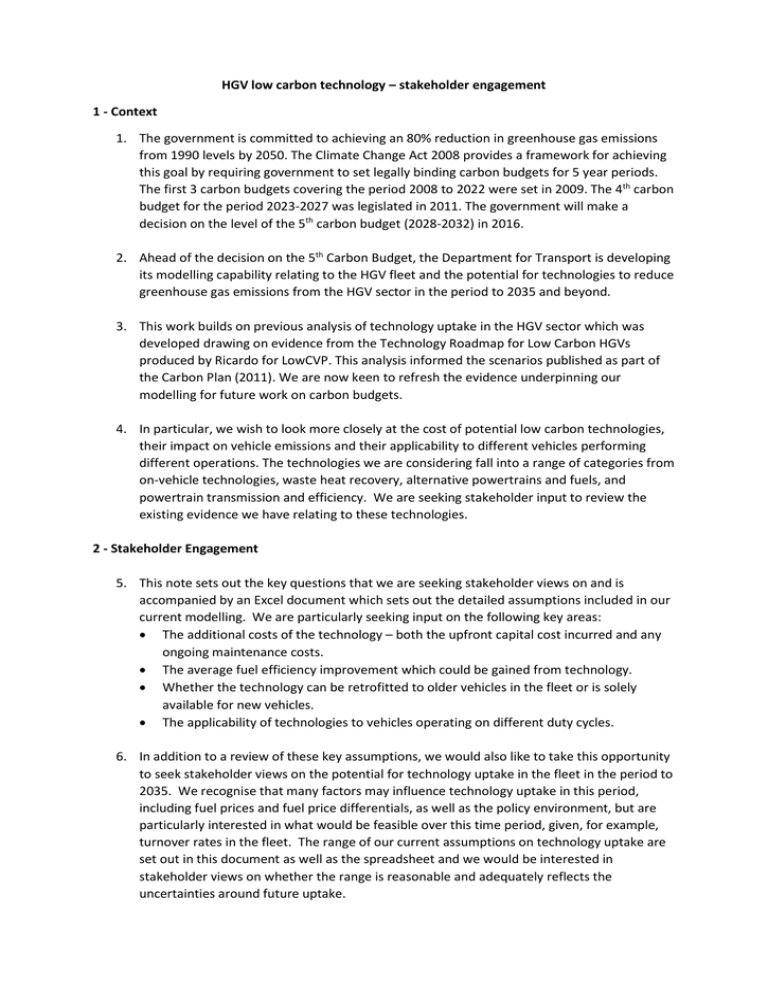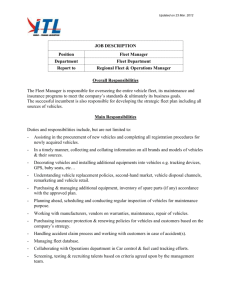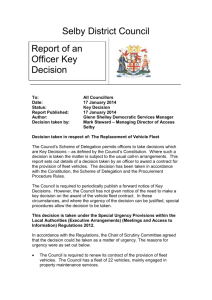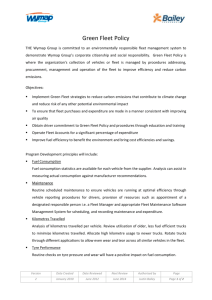HGV low carbon technology
advertisement

HGV low carbon technology – stakeholder engagement 1 - Context 1. The government is committed to achieving an 80% reduction in greenhouse gas emissions from 1990 levels by 2050. The Climate Change Act 2008 provides a framework for achieving this goal by requiring government to set legally binding carbon budgets for 5 year periods. The first 3 carbon budgets covering the period 2008 to 2022 were set in 2009. The 4th carbon budget for the period 2023-2027 was legislated in 2011. The government will make a decision on the level of the 5th carbon budget (2028-2032) in 2016. 2. Ahead of the decision on the 5th Carbon Budget, the Department for Transport is developing its modelling capability relating to the HGV fleet and the potential for technologies to reduce greenhouse gas emissions from the HGV sector in the period to 2035 and beyond. 3. This work builds on previous analysis of technology uptake in the HGV sector which was developed drawing on evidence from the Technology Roadmap for Low Carbon HGVs produced by Ricardo for LowCVP. This analysis informed the scenarios published as part of the Carbon Plan (2011). We are now keen to refresh the evidence underpinning our modelling for future work on carbon budgets. 4. In particular, we wish to look more closely at the cost of potential low carbon technologies, their impact on vehicle emissions and their applicability to different vehicles performing different operations. The technologies we are considering fall into a range of categories from on-vehicle technologies, waste heat recovery, alternative powertrains and fuels, and powertrain transmission and efficiency. We are seeking stakeholder input to review the existing evidence we have relating to these technologies. 2 - Stakeholder Engagement 5. This note sets out the key questions that we are seeking stakeholder views on and is accompanied by an Excel document which sets out the detailed assumptions included in our current modelling. We are particularly seeking input on the following key areas: The additional costs of the technology – both the upfront capital cost incurred and any ongoing maintenance costs. The average fuel efficiency improvement which could be gained from technology. Whether the technology can be retrofitted to older vehicles in the fleet or is solely available for new vehicles. The applicability of technologies to vehicles operating on different duty cycles. 6. In addition to a review of these key assumptions, we would also like to take this opportunity to seek stakeholder views on the potential for technology uptake in the fleet in the period to 2035. We recognise that many factors may influence technology uptake in this period, including fuel prices and fuel price differentials, as well as the policy environment, but are particularly interested in what would be feasible over this time period, given, for example, turnover rates in the fleet. The range of our current assumptions on technology uptake are set out in this document as well as the spreadsheet and we would be interested in stakeholder views on whether the range is reasonable and adequately reflects the uncertainties around future uptake. 7. Finally, we would also be interested in expert views on how the make-up of the fleet might change over time, and, in particular, how the proportion of the fleet operating on different duty cycles may evolve. In particular it would be useful to understand what trends currently exist or can be anticipated which would have a significant impact on vehicle sizes in the fleet, average mileage or usual operation. We have defined the duty cycles we are using in our modelling of the fleet in the attached annex. 8. In section 3 we have set out the main questions we would like you to consider. It would also be useful to hear about any new evidence or supporting literature that we should take account of in developing our modelling assumptions. 9. The evidence that we receive in response to our stakeholder engagement will be reviewed and used as input assumptions in DfT’s future modelling of HGV low carbon technologies. We appreciate that some data may be commercially confidential and we will ensure that such data remains confidential and is aggregated to avoid identification. 3 – Questions 10. Attached to this document is an excel document entitled “DfT Stakeholder form”, which contains 7 worksheets. We are seeking input on the capital and maintenance cost assumptions set out within these worksheets, as well as the average fuel consumption saving of each technology listed and are asking stakeholders to review and, where possible, provide updated values for each technology under the appropriate duty cycle. 11. The current assumptions are presented by duty cycle and it is assumed that not all technologies would be applied to vehicles operating on a specific duty cycle. Excluded technologies are listed on each worksheet and we would be interested in your views on whether we have made the right assessment of applicability for the individual technologies. 12. In addition we would appreciate your responses to the following questions: a. Are there any trends you predict will have an impact on fleet make-up out to 2035? Do you anticipate significant changes in vehicle size or operation across the fleet? b. Are there any emerging technologies which we haven’t taken account of which you believe could play an important part in decarbonising the HGV fleet in 2035? 13. We would like to seek your views on the feasible potential uptake of the specified technologies across the fleet. We have provided the detail of DfT’s current uptake assumptions under low and high uptake scenarios in the attached spreadsheet on sheet 7. No specific assumptions have been made about the policies that might be required to drive this uptake but the relative uptake rates across different technologies have been informed by our previous assessment of cost-effectiveness. Improvements to tyres and aerodynamics for long haul and regional delivery duty cycles are not included here. Our previous analysis has suggested that these technologies are cost-effective and therefore we would see uptake of these technologies under a business-as-usual scenario. 14. Finally we would be interested in your views on what policy measures might be required in order to deliver the levels of uptake you believe are feasible out to 2030. Annex 1 : Duty cycle definitions For the purpose of the modelling, we intend to break down the HGV fleet into the UK into the following 6 categories: Municipal Utility - Low speed, many stops e.g. refuse collection, sweepers. Construction - Construction site vehicles with delivery from central stores to few local customers e.g. tippers, concrete mixers. Long Haul -Delivery to national and international sites. Long periods of high constant speed with few periods of urban operation Regional Delivery - Delivery of goods from a regional warehouse to local stores. Includes periods of constant high speed and urban operation. Urban Delivery - Delivery of goods mostly in cities or suburban areas. Includes frequent stop start driving. Service – Rigid vehicles of <=7.5tonnes which operate in a similar manner to urban delivery vehicles. Annex 2 – Definitions of technology The definitions set out below have been drawn from two reports relating to low carbon HGV technology: A review of the efficiency and cost assumptions for road transport vehicles to 2050 (AEA, 2012); and Reduction and testing of GHG emissions from HDVs (AEA, 2011) If there are technologies not covered please provide brief descriptions and performance evidence for them to be considered for inclusion in the final model i. ii. iii. iv. v. vi. vii. Single Wide Tyres: Replacement of dual tyres on an axle with a lower aspect ratio single wide tyre Spray Reduction Mudflaps: The mud flap separates the water from the air through a series of vertical passages created by vanes which makes the spray change direction a number of times eliminating the water. Aero Fairings: Additional add-ons to cabs that help reduce aerodynamic drag and improve fuel consumption. Includes cab deflectors and cab collars and can be retrofitted. Aero Trailer Bodies: Trailers / bodies designed to improve vehicle aerodynamics, e.g.: teardrop shapes, or those integrating multiple aerodynamic features into a complete package. Predictive cruise control: Systems that use electronic horizon data to improve the fuel efficiency of vehicles, combining GPS with Cruise Control to better understand the road ahead for optimal speed control. AMT (Automatic Manual Transmission): A manual layshaft transmission which has automatic actuation of gearshifts and clutch operation Pneumatic Booster: Compressed air from vehicle braking system is injected rapidly into the air path and allows a faster vehicle acceleration, which allows an earlier gear shift (short shifting), resulting in the engine operating more in an efficient engine speed / load range. viii. ix. x. xi. xii. xiii. xiv. xv. xvi. xvii. Electrical turbocompounding: Exhaust turbine used in combination with an electric generator / motor to recover exhaust energy: (i) Recovered energy can be stored or used by other electrical devices; (ii) Motor during transients to accelerate. Gas engines: Either dedicated gas or dual fuel engines which allow the vehicle to run fully or partially on natural gas/biomethane or other road fuel gases. Alternative fuel bodies: Replacement of existing power sources for vehicle bodies which use diesel for power. For body types with high auxiliary requirements like Refuse Collection Vehicles, refrigerated transport (and some construction vehicles), additional efficiency gains can be achieved by powering these systems via electric battery storage or alternative fuels, rather than off the main engine. Flywheel Hybrid: An additional flywheel that stores and releases energy. The flywheel stores energy, while braking for example, releasing it to supplement or temporarily replace the engine output Stop Start system: System uses a high-voltage e-motor mounted to the crankshaft to operate stop / start, i.e. stopping the engine running whenever the vehicle is stationary, along with regenerative braking Electric vehicles: Vehicle is driven by an electric motor powered by batteries which are charged from mains electricity. The vehicle has no other power source other than the battery Mechanical turbocompounding: Exhaust gas energy recovery with additional exhaust turbine, which is linked to a gear drive and transfers the energy on to the crankshaft providing extra torque. Heat Recovery: Exhaust gas energy recovery with heat exchangers. Sometimes called “bottoming cycles”, this concept uses exhaust gas heat in an exchanger to drive an additional power turbine to generate energy. Similar to the secondary heat recovery cycle for light duty vehicles. Weight Reduction/lightweighting: Intensive use of aluminium alloys in tractor chassis and body, trailer and powertrain achieving total combined unit weight savings of up to 2,000kg or around 900 kg for tractor body and chassis. Full Hybrid: Typically implemented as hybrid electric vehicles where electrical energy is stored in batteries which can be used to drive an electric motor to power the vehicle or supplement engine power






